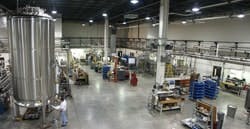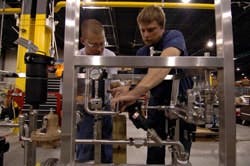Separations experts may argue otherwise, but fermentation and cell culture are what biotechnology is all about — the sine qua non of bioprocessing. Facilities, equipment and cells are the three pillars of large-scale fermentation.
Biologicals developers who prefer to maintain full control over products must plan fermentation or cell culture facilities (which will be discussed broadly as cell culture facilities in this article) as carefully as they select a cell line in which to express their product.
Planning, designing and building cell culture facilities present "dual challenges" of creating the perfect environment for current products while maintaining flexibility for contingencies — typically drugs that fail testing and must be replaced, says David Marks, founder and president of DME Alliance, Inc. (Allentown, Pa.), which specializes in cGMP bioreactor design. Marks, who formerly worked "down the road" at bioreactor fabricator ABEC and who now represents that company, offers the following advice:
- Understand process and business goals
- Create a contingency plan, which includes expansion if a product is highly successful
- Build in flexibility in anticipation of products dropping from the picture or, in the case of successful products, as their lifecycles mature.
Risk mitigation in facility design and construction depends on the size of the proposed facility. Pilot plants' flexible designs reflect the number and types of products they must handle. At this scale, Marks suggests making "rational" use of disposable plastic equipment for storage and even reactors, and keeping processing scales manageable. "If nothing else, after you're done building you can use it as a toll manufacturing facility," he says.
With full-production facilities, which are often dedicated to a single, successful product, flexibility is much more elusive. Long timelines between concept and construction dampen most sponsors' enthusiasm for built-in flexibility. Moreover, large scale demands more automation, greater physical layout for equipment, and hard-wired utilities.
This is not to say that flexibility is unachievable at very large scale. But it won't come cheap. One way to hedge bets for super-large facilities is to set aside shell space, perhaps with bare-bones utilities servicing those areas.
As the design emerges, sponsors can expand into the free space as needed. "I've seen projects where the owner has taken that approach and, before completing the core facility, discovers uses for the free shell space," says Marks. "Space has a tendency to disappear as the detailed design progresses."
Some flexibility may be gained by specifying, if not acquiring, long-lead-time equipment early. Production-worthy bioreactors, for example, can take six months or longer to design and build to owners' specifications, especially if simultaneously ongoing process development suggests tweaking the original design.
"For a relatively small investment as a percentage of total cost, it often pays to do preliminary engineering and conceptual design, before pulling the trigger and moving forward with the project," Marks notes. "Problems arise when owners try to complete engineering while building is going on. In this scenario they're assuming risk with each piece of equipment they purchase, and with every commitment made with regard to facility construction."
Small is big
Large-scale cell culture came of age with the success of high-dose, chronically administered monoclonal antibodies (MAbs). While the number of cell culture processes with 10,000L, 20,000L, and higher capacities is growing, most cell cultures are smallish operations ranging from a few hundred mLs to several thousand liters of working volume. In biotech, 100 Ls typically divides pilot plants from full-scale manufacturing. Smaller units are typically skidded.
The interplay between cell culture productivity and process size is a theme we'll be hearing a lot about over the next few years. Different vendors note different trends. Globally, more biopharmaceutical manufacturers are becoming more interested in larger capacity bioreactors, says Mike Sattan, marketing director for New Brunswick Scientific (NBS; Edison, N.J.) And, despite the success of cell culture products, he says that interest in microbial fermentation has not abated.
NBS specializes in bioreactors in the 75- to 3,000-L range and somewhat smaller microbial fermentation vessels, focusing on biotech's "sweet spot": small to mid-sized manufacturers and sponsors with development-stage products that typically need equipment quickly, often within three months of concept.
The company is working with Wave Biotech (Bridgewater, N.J.), a specialist in bio-disposables, to incorporate NBS's FibraCel disks into Wave's Cellbag disposable bioprocess bags. Cells, especially those of the anchorage-dependent variety, attach readily to porous, polymeric FibraCel disks.
The NBS collaboration provides Wave customers with the potential of multiplying effective cell density within the same culture volume. With cells that secrete proteins, the combination of FibraCel and disposable bags creates a relatively inexpensive route to perfusion cell culture.
Wave has also partnered with Nunc (Rochester, N.Y.), known for its cell culture bottles, to incorporate Nunc's 2DMicroHex carriers, which work similarly to FibraCel, into disposable process bags. 2DMicroHex carriers are flake-like polystyrene hexagons about 125 μm in diameter. Nunc coats them with Nuclon, the same material it uses to make its T-flasks.
But big is bigger
Cell culture customers are specifying more flexibility in fermenters and bioreactors. "They're not always buying for specific products, as much as they are to cover more bases," says Todd Jones, vice president of product development at ABEC (Bethlehem, Pa.), ABEC says demand for its largest bioreactors has leveled but is still strong across the board, particularly from contract manufacturing organizations (CMOs). "Super-huge projects aren't out there as much as in the past," says Jones, "but we have a good backlog of orders and lots more on the horizon."
ABEC's basic production size, typical for very large-scale process vessel fabricators, is about 2,000 L working volume. All units are custom-built and take between seven and eight months to deliver. Design takes about half that time, says Jones. "If they want a standard design, they can perhaps get it in 14 weeks, but we can't customize it in that short amount of time."
Large-scale biotech customers are specifying fewer mega-reactor projects — i.e., those with 10,000 L or more of bulk capacity, says Sartorius-BBI's (Bethlehem, Pa.) senior vice president Leonard J. Goren. However, like NBS, Sartorius is seeing increased growth in demand for tanks of 2,500 Ls and lower. Goren identifies process yield improvements plus a saturated market for large-scale capacity.
Sartorius customers are also more interested in process analytics, which requires the company to invent and integrate embedded analytical technologies into already complex equipment. Sartorius has entered partnerships with vendors of sensors and analytical instruments to create custom packages for customers who specify a high level of in-process monitoring.
After acquiring Braun in May 2004, Sartorius consolidated operations from four smaller buildings into a new, 85,000-square-foot manufacturing site. The company has also expanded its product line to include more media preparation and filtration, crossflow filtration (both micro- and ultrafiltration), harvest systems and support equipment like clean-in-place and waste inactivation units.
Media, not bioreactors, the key to higher productivity
Improvements in cell culture productivity have been breathtaking and may eventually bring back the days when 1,000-L working volumes were considered huge. Since the birth of biotech in the early 1980s, cell masses have increased 15- to 20-fold, cell cultures now run about three times as long and cells now double an average of six times instead of three.
Cell line engineering and general process development deserve some credit for making cell culture what it is today, but most of the credit goes to cell culture media, says Dr. Florian Wurm, professor of biotechnology at the Swiss Federal Institute of Technology (Lausanne). "The medium, and not bioreactors or cell line engineering, is clearly the most important factor," he says. "It's a myth that you need special bioreactors to grow cells. All you really need is sterility and a homogeneous supply of oxygen and nutrients."
Supporting Wurm's contention is the fact that specific productivity has increased only marginally since the early 1990s, from about 50 picograms per cell per day to about 80, and is unlikely to break the 100 pg barrier any time soon. Had cell line engineering been as efficient as media, one would expect at least a few doublings in cells' innate ability to churn out protein.
Even at today's phenomenal densities of 10 million per mL, mammalian cells make up 2% or less of reactor volume while yeast and bacteria fill 30%. Wurm believes animal cells could achieve comparable densities and even higher productivity, resulting in a 50-fold increase in volumetric productivity within a decade.
Despite the scientific case for working on media, developing custom nutrient blends takes months and is not easily defended during hectic product launches. Reproducible high-throughput methods have been elusive due to issues with evaporation, mixing and maintaining homogeneity in ultra-scaled-down systems. Plus, each experiment requires the time for five or more cell mass doublings — roughly one day per doubling — and a reliable assay for protein output. It's tricky business because cells that double every 18 hours may be limited to three doublings, while those that take a day to reproduce might have half a dozen doublings in them.
The startup company, ExcellGene (Monthey, Switzerland), founded by Wurm, is developing a semi-high-throughput media screening system for testing up to 300 media conditions per day in 50-mL microreactor tubes. Eventually Wurm or some other clever cell biologist will figure out a way to measure ultimate cell productivity through some property that manifests itself over hours instead of days. Until then, cell productivity must be earned the old-fashioned way.
|
Doing Facilities Right For most development-stage biotechs, building or acquiring cell culture capacity is a matter of life or death. Do it right and you at least enjoy the opportunity to get product out the door. Do it late and you get acquired (if you're lucky). Do it wrong and it's curtains. With half of all active cell culture facilities manufacturing products other than the one(s) intended when the first blueprints were drawn, smart owners should adopt measures to mitigate the uncertainty inherent in building and financing flexible facilities:
|








